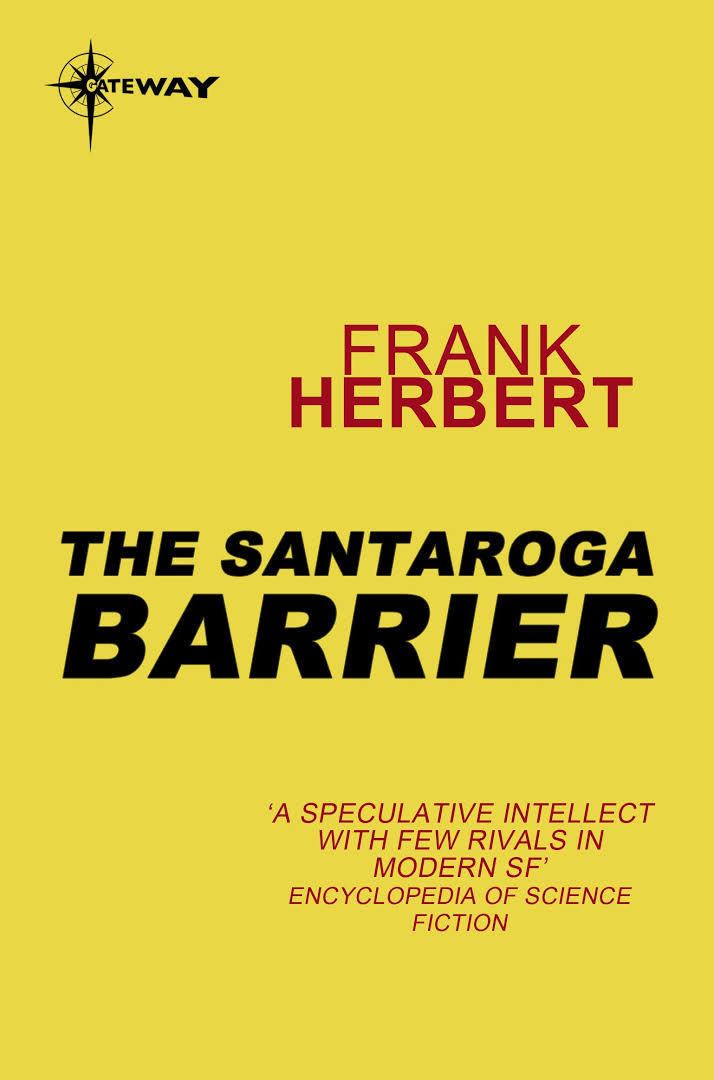7.2 /10 1 Votes7.2
Language English Pages 255 pp Originally published 1968 Genre Science Fiction Cover artist Paul Lehr | 3.6/5 Goodreads Publication date 1968 ISBN 0-7653-4251-0 Country United States of America | |||||||||||||||||||||||||||||||||
 | ||||||||||||||||||||||||||||||||||
Media type Print (hardback & paperback) Similar Frank Herbert books, Science Fiction books | ||||||||||||||||||||||||||||||||||
The Santaroga Barrier (1968) is a science fiction novel by Frank Herbert. It is considered to be an "alternative society" or "alternative culture" novel. The Santaroga Barrier deals with themes such as psychology, the counterculture of the 1960s, and psychedelic drugs. It was originally serialized in Amazing Stories magazine from October 1967 to February 1968, and came out in a paperback from Berkley Books later in 1968. The book has been described as "an ambiguous utopia" and Herbert himself stated to Tim O'Reilly that The Santaroga Barrier was intended to describe a society that "half my readers would think was utopia, the other half would think was dystopia."
Contents
Plot summary
A psychologist, Gilbert Dasein, is hired by corporate interests to investigate a southern California town in a valley where marketing seems totally ineffective: outside businesses are allowed in, but wither quickly for lack of business. Santarogans aren't hostile toward the enterprises, they just won't shop there. Nor are they xenophobic; they instead appear maddeningly self-satisfied with their quaint, local lifestyle. Adding an element of danger, the last few psychologists sent in have all died in accidents that are (seemingly) perfectly plausible. Complicating matters further still, the psychologist's college girlfriend, Jenny, has returned to Santaroga, her hometown.
With this in mind, Dasein cautiously enters the town and quickly learns of 'Jaspers', an additive in the food and drink commonly ingested in Santaroga that seems to imbue the consumer with greater health and an expanded mind. Within the Santarogan community Jaspers was described as "Consciousness Fuel" which opened a persons eyes and ears, and turned on their minds. Those who consume it don't become psychic; instead, they're simply far more lucid than the average citizen of the U.S, although there are numerous hints at a group mind operating at a subconscious level. Their newspapers are vaguely subversive with their folksy, enlightened commentary on world affairs; their dinner conversations knowledgeably reference great theories of psychology, politics, and cognitive science.
Soon, Dasein is having narrow misses with perfectly plausible accidents: a clerk adjusting valves in the kitchen floods Dasein's hotel room with gas; Dasein trips on some loose carpeting, stumbles, falls through a stairwell railing and would have plunged three floors but was caught and saved by a Santarogan; Although the incident with the carpeting and fall through the stairwell railing appeared to be a fluke accident, Dasein later realizes it could have been part of a carefully laid trap; a boy playing with a bow and arrow releases it, grazing Dasein's neck; the lift under his car in a garage collapses; a waitress in a diner accidentally uses insecticide rather than sugar for his coffee. Knowing that Jaspers creates exceptionally perceptive, penetrating individual minds, Dasein realizes that he has offended a communal id that feels threatened by him. As Jenny tries to convince him to settle down with her there, he wonders whether he'll live long enough to decide.
Reception
David Pringle rated The Santaroga Barrier three stars out of four and described the novel as "one of Herbert's more effective treatments of the hive mentality-and the possible next step in the evolution of human intelligence."
